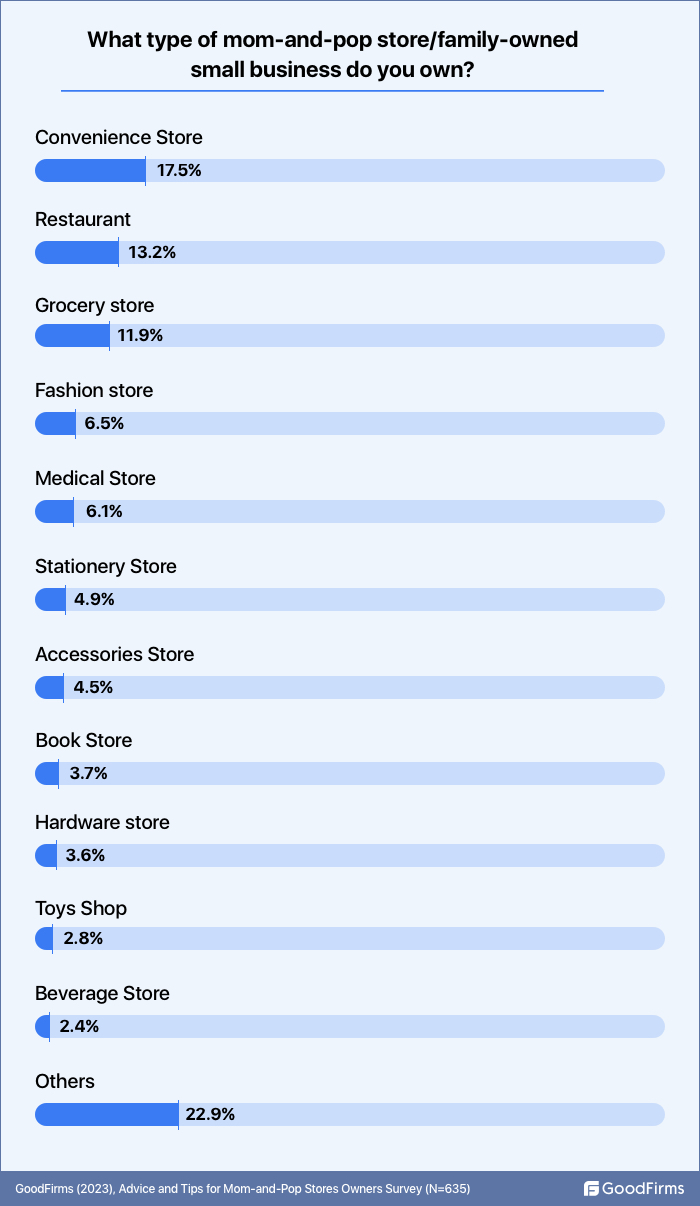ABSTRACT:
Mom-and-pop stores are traditional family-owned businesses with a small number of employees (many of these employees are family members themselves) and usually have their store at a single location. Many of the present-day corporate giants and big retailers, such as Walmart, Nike, Dell, Whole Foods, Spanx, Reliance, etc., started as mom-and-pop stores, as casual players in the market. Mom-and-Pop stores have a close connection with their local community and great brand loyalty owing to their personalized and interactive services and face-to-face relationships with customers. With the e-commerce surge, these stores are also participating in online selling and, therefore, expanding their reach beyond their local community customers.
However, mom-and-pop stores are facing huge competition and are fighting a survival war with the large-house retailers who have adopted the latest technologies to provide hyper-personalized services similar to the mom-and-pop stores. Large retailers also benefit from economies of scale to provide products at lower prices than mom-and-pop stores. Still, after the pandemic, there is a rising sentiment among consumers to support their local businesses, and mom-and-pop stores are also finding new ways to keep them relevant in the digital age.
The survey titled: ‘Advice and Tips for Mom-and-Pop Store Owners, From Mom-and-Pop Store Owners’ aims to analyze the current state of Mom-and-Pop stores, their business environment, trends, and the challenges they face to survive and sustain. GoodFirms’ survey also attempted to understand the growth initiatives, strategies, pain points, processes, etc., of the Mom-and-Pop stores.
Table of Contents:
Top Tips for Running Successful Mom-and-Pop Store
Impact of the Pandemic on Mom-and-Pop Stores
Mom-and-Pop Stores Outstands Big-Box Retailers
Significant Challenges of Running a Mom-and-Pop Shop
Role of Internet and Social Media on the Growth of Mom-and-Pop Stores
Types of Business Software Applications Supporting Mom-and-Pop Stores
Introduction
"Mom and Pop" is a name generally used to describe the privately owned and family-run retail business or any convenience establishment managed with small level sales. Such stores are spread across all industries covering from eateries to garments stores to grocery stores to money lending stores. Shoppers in the community will know these stores well. They were famous without the internet, without social media, and without digital technologies.
Mom-and-pop stores generally sell local products and services which are located in a single place. Instead of being a part of a large national chain, the store sells to shoppers who are locally known persons in the community and town. Even though the number of large retail chains has significantly increased, local consumers still prefer shopping at independent, small-sized mom-and-pop stores. Market size for mom-and-pop shops is expected to reach $227.21 billion by 2027 at a CAGR of 15.8%.(1) Many of these locally-owned businesses are still open and even doing well in the current economic landscape due to the fact that they are easily accessible, offer personalization and exceptional service.
Mom-and-pop stores include a wide range of businesses, such as restaurants, bookstores, fashion stores, grocery, stationary supplies, convenience stores, medical shops, etc. Compared to large chain suppliers and retailers, e-commerce companies, and franchise businesses, mom-and-pop businesses sometimes suffer significant disadvantages in many ways such as lower economies of scale, lack of capital investments, limited advertising budgets, lack of visibility, etc.(2)
‘Advice and Tips for Mom-and-Pop Stores Owners, From Mom-and-Pop Stores Owners’ is a survey conducted by GoodFirms that uncovers interesting insights regarding the importance of mom-and-pop stores in the retail landscape and top tips for running stores successfully. The survey also reveals the current business environment, consumer perception, the positive impact of the pandemic, how their future is fueled by advancement in tech and social media, and the favorability of the local market for mom-and-pop stores and startups.
Survey And Data Analysis
GoodFirms surveyed 635 Mom-and-pop business owners worldwide to analyze the primary challenges mom-and-pop store owners face and how to overcome these barriers and thrive in the market.
Below are the survey findings and their analysis:
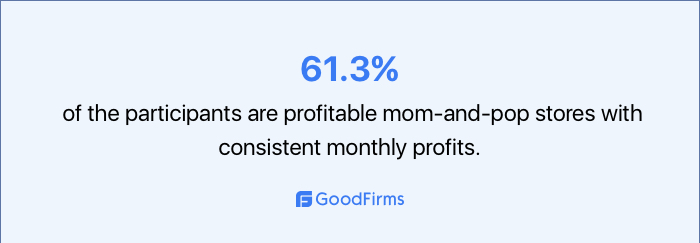
GoodFirms survey found that 61.3% of the mom-and-pop owners are recording consistent monthly profits. The survey reveals the viability of the mom-and-pop retail business model. In the United States, there are more than 7 million mom-and-pop stores.(3) Despite the competition that the mom-and-pop stores encounter from big-box stores, e-commerce companies and other online sellers, they are consistently making profits. Local shoppers are the major contributors for this success.
"As a business leader, I recognize the invaluable contribution of mom-and-pop stores in preserving diversity and offering a personal touch that larger corporations often lack." - Indra Nooyi, Former CEO of PepsiCo
The following are the factors contributing to the growth of mom-and-pop stores:
-
Mom-and-pop shops are known for their personal touches. Customers feel like they are getting a more individualized shopping experience as compared to shopping online.
-
Mom-and-pop stores offer a wide range of goods and services at affordable prices as compared to large chain retailers. They can deliver goods that are in demand.
-
Mom-and-pop shops are very flexible, can open the store any time just for one customer, and thus they are well renowned for providing excellent customer service.
-
Mom-and-pop businesses aim at providing superior quality goods and services to their customers. They ensure providing their clients with the finest experience possible.
-
Mom-and-Pop stores allow customers to bargain and get the best deal. This stands as the major advantage in comparison to the tagged, fixed price offered by several big retailers.
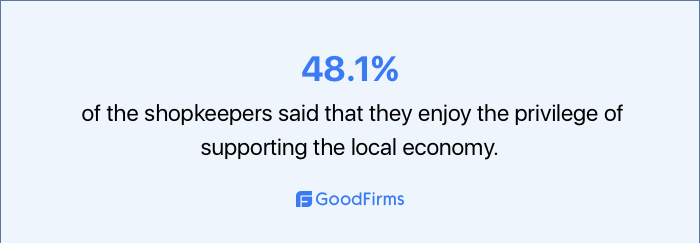
-
48.1% of the shopkeepers said that they enjoy the privilege of supporting the local economy. Mom-and-pop stores enjoy supporting the local economy because it allows them to serve the community that has supported them. These small and independent businesses provide personalized and unique goods and services to cater to the specific needs of the local population. Furthermore, these shops in generating employment opportunities for the local people, thus fostering good relations among the community people.(4)
Top Tips for Running Successful Mom-and-Pop Stores
“Mom and Pop stores face a unique challenge in creating brand awareness. Unlike their counterparts (big box stores and franchises), they lack brand recognition, so they have to work harder to build connections with their target audience. The best way to do this is to create foot traffic in their brick-and-mortar store. We always encourage our clients to host influencer events and incentivize bloggers and content creators to post on behalf of the brand. This user-generated content helps raise awareness among the influencer’s audience and can be repurposed on the store owner’s social media and website. This also helps build trust and FOMO; as a result, others are compelled to visit the space and be like their favorite influencer.
Another tactic is creating in-store-only promotions that the business owner shares across all social media channels, including YouTube and YouTube Community. These messages must reach the target audience a minimum of 7 times to be effective, so it is encouraged that the business owner dedicates a small marketing budget and use tools like Facebook Pixel to remind individuals that this offer is available.
Being small has some advantages that larger retailers lack, such as the ability to niche down. This tactic requires the business owner to do some research with their existing client base and understand specifically what problem their product or services solves. From there, they need to “ignore” all of their other service offerings and solely promote the solution to their audience's problem. Doing so creates a sense of connection that is unbreakable, and once they have the customer’s attention, they can slowly introduce other offerings. Many business owners struggle with this because they want to be everything to everyone. Focusing their efforts on ONE offering is extremely effective and a great way to maximize their marketing efforts.” said Nahamani D. Yisrael, Digital Branding Expert & Entrepreneurship Educator at Nahamani.org
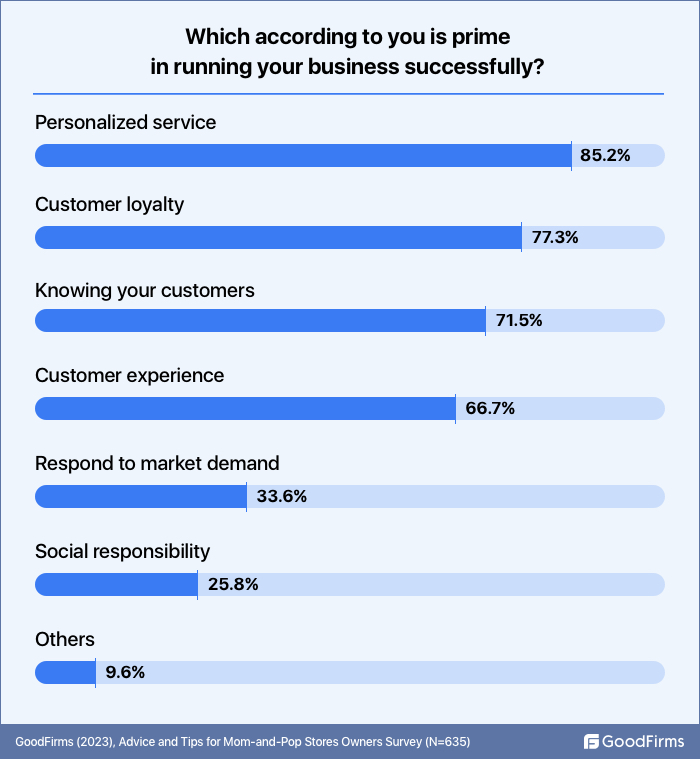
Personalized Services
85.2% of the surveyees said that customers visit their stores regularly because they offer personalized services.
Mom-and-pop stores focus on creating relationships with customers and aim at delivering personalized shopping experiences to them. These stores thrive to provide unique and memorable purchasing experiences by giving personal attention, genuine recommendations, customized services and other special services to their customers in order to foster customer satisfaction and loyalty.
Customer loyalty
77.3% of the surveyed owners consider customer loyalty as one of the prime factors in running their business successfully.
Mom-and-pop store owners prioritize building strong customer relationships because a loyal customer base helps them to stand out from their larger competitors. Thus, customer loyalty is the key driving source of their business sustenance.
Knowing your customers
71.5% of the survey participants believe that knowing the customers and their needs is an essential factor that mom-and-pop store owners practice.
Knowing and understanding customer requirements results in higher customer satisfaction and happiness, helps in providing personalized services, fosters customer loyalty and gives them a competitive advantage in the market. Thus, mom-and-pop stores can build strong customer relationships and can thrive in local markets by prioritizing consumer needs
“I have learned that prioritizing customer satisfaction is crucial. Providing a warm and personalized experience for your customers can go a long way in building strong relationships and fostering loyalty. Another important aspect is adaptability. In today's ever-changing market, it's essential to remain open to new ideas and willing to take calculated risks. Whether it's exploring new products or refining your marketing approach, being flexible can help your business thrive. Lastly, don't be afraid to seek guidance from other business owners or industry experts. Collaborating and learning from others' experiences can provide valuable insights and help your business grow.” said Martina Genao, the Director of Operations at the Emergency Plumbing Squad.
Customer experience
66.7% of the survey respondents said that they believe in providing the best shopping experience to their customers.
Mom-and-pop store owners must excel in providing a customer-focused experience by offering customized services, greater flexibility, support to locals, attention to detail and a distinctive shopping environment that most people appreciate.
Respond to market demand
33.6% of the surveyees said that actively responding to market demands is a vital component of their business success.
The mom-and-pop store needs to consistently monitor and respond to the rapid change in market demands. Mom-and-pop shops must adjust their strategies and plan according to market demands in order to stay competitive in the market.
Social responsibility
25.8% of the surveyed owners said that customers prefer buying goods/services from socially responsible stores.
Social responsibility is a vital aspect for mom-and-pop stores as it helps in enhancing their reputation in the market and attracting socially conscious customers. Minimizing the store’s impact on the environment and adopting eco-friendly activities can contribute to the well-being of the community as well as the planet.
Other
9.6% of the surveyed owners also follow other strategies such as setting long-term objectives, forecasting budgets, training employees and using inventory management tools.
Impact of the Pandemic on Mom-and-Pop Stores
GoodFirms survey revealed that 31.7% of the survey respondents said that the Pandemic had positively affected their stores.
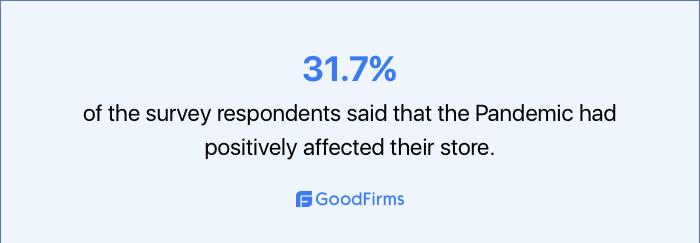
COVID-19 had a major impact on the operations of the retail industry, with many big-box retailers and various large chains closing their operations due to low footfall. But on the contrary, mom-and-pop stores had an overall positive impact of the pandemic as these stores made themselves easily available, serving the needs of the locals during the period of lockdown.
Following are some of the positive impacts caused by the pandemic on mom-and-pop stores:
-
Due to the sudden shutdown of the market and big box retailers, consumers shifted to buying their day-to-day items from retail stores. Thus increasing the foot traffic in mom-and-pop stores.
-
Regular purchasing from these stores built a stronger connection between customers and the storekeepers. Offering personalized goods and services as per customer requirements boosted customer loyalty and better customer relationships.
-
Mom-and-pop stores generally have small crowds which were best suitable during the lockdown phase and thus provided a safer zone for customers to make their purchases during the pandemic.
-
Mom-and-pop stores are located in local areas, thus making these stores easily accessible to the community people in that locality.
-
COVID-19 helped people to realize the value of local goods and services when they were turned on for fulfilling their basic needs. This has led to a rise in the sales and growth of mom-and-pop stores.
-
The pandemic made mom-and-pop stores adopt and coordinate with technology for mundane tasks such as online ordering, in-store pickup and offering delivery services to their customers. Therefore, adopting new tech helped mom-and-pop stores to reach new customers and enhance their services.
In short, the COVID-19 pandemic had an overall positive impact on mom-and-pop stores while some struggled to increase their sales. Mom-and-pop stores hold an important position in the retail landscape and their future looks bright in the industry.
Mom-and-Pop Stores Outstands Big-Box Retailers
According to the survey conducted by GoodFirms, 51.8% of the Mom and Pop stores are unaffected by the presence of big-box retailers near them.

"The charm and authenticity of mom-and-pop stores are irreplaceable. They offer a more intimate shopping experience and a genuine connection with customers that cannot be replicated in a larger retail setting." - Howard Schultz, Former CEO of Starbucks.
Socially Responsible
As mom-and-pop stores are locally owned businesses, they tend to be more involved in their community activities such as charity, donations, sponsoring local events and supporting their fellow local business owners. This helps in building customer relationships and a sense of belongingness and loyalty among customers.
But, despite a few advantages, there are several challenges that these small family-owned businesses face.
GoodFirms, in its survey, tried to gather information on the key challenges that mom-and-pop stores face in their business. Here is the result for the same;
Significant Challenges of Running a Mom-and-Pop Shop

Pricing Competition
85.2% of the survey participants mentioned pricing competition as the prime challenge in running their mom-and-pop business.
One of the top barriers that mom-and-pop stores face is the pricing competition from their fellow stores, online retailers and big box retailers. Mom-and-pop stores can not buy products in bulk like big box retailers as they enjoy economies of scale and sell these products at low prices to customers.(5) Mom-and-pop stores while on the other hand have to cover their costs and cannot further sell products at lower costs.
Day-to-Day Reliance on Wholesalers and Distributors
77.5% of the surveyed mom-and-pop shop owners revealed that another challenge is their high dependency on wholesalers and distributors.
Wholesalers and distributors play an important role in supplying goods to mom-and-pop stores. Mom-and-pop stores have narrow access to the variety of products to sell as compared to the variety offered by e-commerce platforms.
Competition with Big-Box Retailers
48.2% of the surveyees said that they face high competition with big-box retailers.
Mom-and-pop stores majorly face competition from big box retailers in terms of variety and prices. Big box retailers offer a wide range of products to customers to choose from as per their choice and also at a reasonable price. Mom-and-pop stores can offer a limited range of products and their prices can be higher at times as they have to cover their profits too.
Liquidity/Lack of Capital for Investment
42.4% of the survey respondents believe that lack of capital for investment is a barrier to their business.
Most of the mom-and-pop stores lack capital for investment which results in not being able to cover their overhead expenses, funding expansion opportunities, or launching a new product to market. Therefore, liquidity is a common barrier to the family-owned and locally operated stores.
Financial Vulnerability
39.5% of the survey participants said that financial vulnerability is one of the challenges they face while running their mom-and-pop stores.
Another challenge is the ability to recover from sudden economic shocks. It is challenging for startups and mom-and-pop stores to recover from huge financial losses in their business. Product damages, low-profit generation, long-term low sales and uncontrollable increases in business expenses are a few factors that can affect the profits of the mom-and-pop stores.
Lack of Product Visibility Due to Limited Space
35.2% of the mom-and-pop store owners revealed that the lack of product visibility due to limited space act as a barrier to them.
Mom-and-pop store owners largely face a lack of product visibility and limited space challenge in their business as compared to large chain stores. They generally have large stores with more space and abundant availability of resources to make their products easily visible which mom-and-pop stores lack.
Lack of Risk Diversification
30.6% of the survey participants said they lack risk diversification.
It is a challenging task for startups and mom-and-pop shops to diversify their risk by spreading it across different investments and assets. Risk diversification requires a huge amount of resources which mom-and-pop stores might not have and risk diversification also requires proper time and expertise which they might lack.
Low Purchasing Power
24.7% of the surveyees revealed that they face low purchasing power.
Mom-and-pop stores lack access to a variety of resources and can not enjoy economies of scale compared to big box retailers and large chains. Due to less capital investment mom and pop stores suffer from low purchasing power and also lack the ability to offer discounts on their products like large chains to their customers.
Lack of Market Insights
21.3% of the survey respondents consider a lack of market insights as a barrier to their store’s growth.
Due to a lack of market insights and the latest trends in the market, mom-and-pop stores can not stay up to date like online and large retailers. Lack of access to updated technology also makes locally owned stores harder to compete with big box retailers.
16.9% and 12.6% of survey participants also mentioned difficulty in reaching a wider audience and hard in introducing their own brands as a barrier to entering and surviving the competition. Whereas 8.4% of the surveyees said familiarity with customers results in increased credit purchases.
Other
4.8% of the surveyed participants said they also face other challenges apart from the above-mentioned barrier in their business such as high rents, increased operating costs, limited access to resources, lack of helping hands, and frequent changes in market trends.
“We opened our store for handcrafted leather bags and accessories 2 years ago in the heart of Barcelona. So we have some experience with the challenges you can face opening a small shop. Foot traffic doesn't come automatically just by opening the store, as nobody knows you yet. Customers first have to learn about your brand. So you will have a time period to build up your awareness in your local area. We had the chance to use this time efficiently by tweaking our concepts and products. As we are a small shop, we do have the advantage over bigger competitors, to be very fast in changing. Talking to and observing store visitors plays a major role in our constant evolution. You start your shop with certain assumptions, and from our perspective, testing and reviewing those assumptions can be a key driver to success. That also means that we strongly suggest keeping resources for future changes in the concept. In that way, we could increase our revenue by 300% year on year.” said Manuel Dreesmann, Founder of Atelier Madre
Role of Internet and Social Media on the Growth of Mom-and-Pop Stores
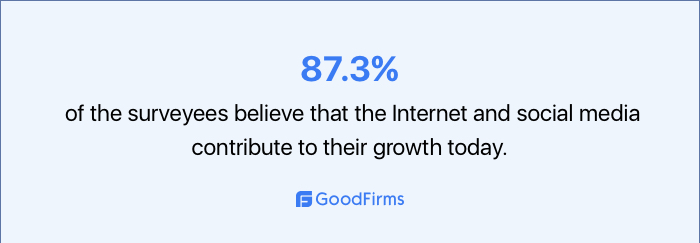
GoodFirms survey revealed that 87.3% of the surveyees believe that the Internet and social media contribute to their growth today. Internet and social media channels have been a boon for all types of mom-and-pop stores and startups.(6) The Internet helped them to expand their business operations and enhanced their brand visibility along with the other advantages as mentioned below;
Increased and Wider Reach: With the help of social media platforms and the Internet, startups and mom-and-pop stores are now able to reach a wider audience and potential customers more quickly than ever before. 72.4% of the surveyed storekeepers said that their prime customers are from the 25-39 years age group. Now through their websites and social media pages, they can reach potential customers worldwide.
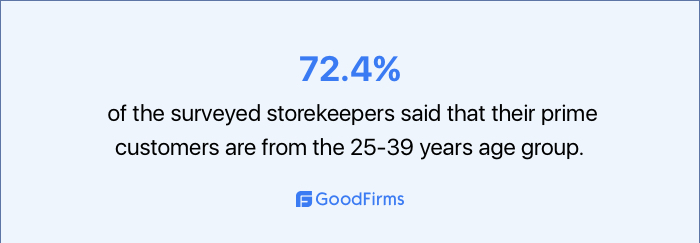
Enhanced Opportunities: Online presence made it competitive for mom-and-pop stores but the Internet has also created new opportunities for them to boost their sales and reach out to new customers.
Enhanced Customer Experience: Social media has played an important role in providing better customer service and experience to mom-and-pop stores and startup clientele. Through social media, mom-and-pop store owners can resolve customer queries, collect their feedback, offer other personalized services, and spread the word of mouth. Thus, this helps in building better customer relationships and loyalty.
Low Marketing Costs: Social media channels and the Internet aids businesses in marketing their products and services freely and with a low budget. This has been proven to be a topmost advantage for those startups and mom-and-pop stores having low budgets for marketing.
Using Analytical Tools for Measuring Results: The Internet provides various analytical tools for measuring and tracking website traffic, conversion rate, lead generation, total sales and customer engagement rate.
“Firstly, I would advise owners to focus on optimizing their operations and driving growth through innovative marketing techniques. This includes using digital channels to promote their business, leveraging social media platforms, and creating an engaging online presence.
In addition, it's crucial for owners to keep a keen eye on their finances and implement cost-reduction techniques where necessary. This could involve negotiating better deals with suppliers, optimizing inventory management, and reducing unnecessary expenses.
Ps- Delegation is the key to success, if you as an owner can’t trust and delegate, it would be very difficult for you to survive.” said Brandon Kent, Vice President at Telemark Diversified Graphics.
Types of Business Software Applications Supporting Mom-and-Pop Stores

Invoicing Software
88.1 of the survey participants said that they use invoicing software in their store to regulate the smooth generation of invoices.
Mom-and-pop stores use invoicing software to generate invoices for goods and services. It helps them simplify the payment process, gather a clear image of their financial position, ensure liquidity and flexibility, and create a sound financial forecast.
Accounting Software
83.1% of the surveyees revealed that they use accounting software to manage their accounts.
Businesses and stores use accounting software to manage and record their daily financial activities such as accounts receivable, accounts payable, sub ledger accounting, reporting, and analytics.
Customer Communication Apps
66.8% of the survey respondents use customer communication apps to encourage the smooth flow of communication between them and their customers.
Mom-and-pop stores use various customer communication apps like Facebook Messenger, Telegram, Viber, WhatsApp, and website messenger to interact with their customers in order to collect feedback, solve their queries and for placing orders. A good communication strategy helps in building strong customer relationships.
POS Application
43.4% of the surveyed store owners said that they take the help of POS applications to manage and monitor their business operations.
POS systems assist small retailers and storekeepers in managing and keeping an eye on a wide range of tasks, including processing payments, maintaining inventories, and reporting sales.
CRM Software
42.2% of the survey participants make use of CRM systems in their stores.
With the help of a CRM solution, mom-and-pop stores manage their marketing campaigns, track service issues, uncover sales possibilities, and manage customer data from one place.
Video Surveillance Apps
34.9% of the surveyees said that they had installed video surveillance devices and applications in their store to monitor their day-to-day activities.
Video surveillance apps help in monitoring systems, movement analysis technologies, anomaly detection, item detection and tracking, and identification, prevention, and warning systems in stores.
Expense Management Tools
31.7% of the survey participants take the help of expense management tools to monitor their business expenses.
Spend management is the planning and monitoring of procurement costs for supplies, services, investments, etc. Businesses and storekeepers use apps like ERP for systematic cost management.
Stock Management Software/Inventory Management Tool
30.7% of the surveyed store owners track and manage their stock and supplies with the help of stock or inventory management tools.
Inventory management software aids businesses in determining which merchandise to order when and in what quantities. Inventory is tracked from product acquisition to sale. Storekeepers use stock management software to guarantee that there is always adequate inventory to complete customer orders and to get proper notification of any shortages.
Retail Management Software
28.4% of the survey respondents said that using retail management software boosts their sales.
Retail management software helps store owners in driving more sales and also includes point-of-sale features, inventory management, retail customer relationship management and more.
Branding Apps
25.7% of the surveyees use branding apps to promote their businesses and stores.
Customers feel more secure and are able to maintain a favorable relationship with startups and retailers that use branding apps for their products/services and business promotion.
Customer Feedback Tools / Survey Apps
12.9% of the surveyed owners said that they use customer feedback tools and survey apps to conduct customer surveys and to collect their customer’s feedback.
Others
And 10.2% of surveyees use other software such as bookkeeping software, email marketing, etc., in their stores.
Future Scope of Mom-and-Pop Stores
"Mom-and-pop stores are the backbone of our economy. They provide jobs, support local communities, and offer a unique shopping experience that can't be found anywhere else." - Barack Obama
The future of mom-and-pop stores looks promising as they are evolving and adapting to new market trends and embracing innovation and technology.(7) There is a significant demand for these mom-and-pop stores and startups despite the growth of online shopping. This is due to the fact that mom-and-pop shops provide various benefits to customers that online retailers fail to offer.
These startups and stores are likely to thrive in the future because they provide a distinctive blend of individualized service, convenience and cater to the needs of local people. Thus, this shows that mom-and-pop shops have a bright future.
Key Findings
-
Mom-and-pop stores hold an important position in the retail landscape and their future looks bright in the industry.
-
GoodFirms survey found that 61.3% of the participants are profitable mom-and-pop stores with consistent monthly profits.
-
48.1% of the shopkeepers said that they enjoy the privilege of supporting the local economy.
-
85.2% of the surveyees said that customers visit their stores regularly because they offer personalized services.
-
77.3% of the surveyed owners consider customer loyalty as one of the prime factors in running their business successfully.
-
GoodFirms survey revealed that 31.7% of the survey respondents said that the Pandemic had positively affected their stores.
-
According to the GoodFirms survey, 51.8% of the surveyees have large big-box retailers near their shops, but they remain unaffected by their presence.
-
GoodFirms survey revealed that 87.3% of the surveyees believe that the Internet and social media contribute to their growth today.
-
72.4% of the surveyed storekeepers said that their prime customers are from the 25-39 years age group.
-
85.2% of the survey participants said that the prime challenge is the pricing competition that they face in their mom-and-pop business.
-
48.2% of the surveyees said that they face high competition with big-box retailers.
-
97.2% of the survey participants said that they use invoicing software in their store to regulate the smooth generation of invoices.
-
88.1% of the surveyees revealed that they use accounting software to manage their accounts.
-
These family-owned stores are likely to thrive in the future because they provide a distinctive blend of individualized service, convenience and cater to the needs of the local people.
Conclusion
Mom-and-pop stores are independent, family-owned businesses that support local economies and local commerce. They offer a unique shopping experience that big-box retailers cannot match. Despite COVID-19's negative repercussions on the world economy, it has had some beneficial impacts on mom-and-pop shops. They are reputed for offering individualized customer attention and creating a unique shopping experience.
The strong rivalry from large chains is one of the biggest barriers for mom-and-pop shops. They find it difficult to compete with the large retailers' economies of scale and marketing resources. Limited resources, tight budgets and smaller staff impedes mom-and-pop stores and startup expansion.
The advancement of the Internet and social media has significantly changed the growth possibilities of the mom-and-pop stores. These platforms offer small shops and startups alternatives for cost-effective marketing and promotion, enabling them to connect with customers around the world without making substantial financial investments. Particularly social media platforms allow direct customer interaction, promote engagement and help in creating a devoted clientele. The Internet and social media platforms assist mom-and-pop shops in building a strong online presence and expanding their customer base.
Therefore, despite the challenges mom-and-pop shops smoothly survive in today's competitive retail industry, they provide great advantages to local communities. Mom-and-pop shops have a bright future ahead of them with ongoing consumer support and efficient use of online platforms, contributing to strong local economies and promoting a feeling of community that is necessary for a thriving society.
We sincerely thank our Research Partners for their valuable insights.
References
-
https://www.researchandmarkets.com/reports/5806871/mom-pop-store-global-market-report#src-pos-2
-
https://www.investopedia.com/terms/m/momandpop.asp
-
https://www.census.gov/library/stories/2022/03/mom-and-pop-businesses-key-contributors-to-united-states-economy.html
-
https://www.reportlinker.com/p06464216/Mom-and-Pop-Store-Global-Market-Report.html?utm_source=GNW
-
https://corporatefinanceinstitute.com/resources/economics/economies-of-scale/
-
https://www.ncbi.nlm.nih.gov/pmc/articles/PMC8215118/
-
https://economictimes.indiatimes.com/industry/services/retail/mom-and-pop-store-day-why-kirana-will-survive-the-corporate-blitz/articleshow/99091239.cms
Survey Participant Demographics:
Firmographics:
The queried business owners comprise 17.5% of Convenience stores, 13.2% of Restaurants, 11.9% of Grocery stores, 6.5% of Fashion stores, 6.1% comprise of Medical Stores, and many more.
